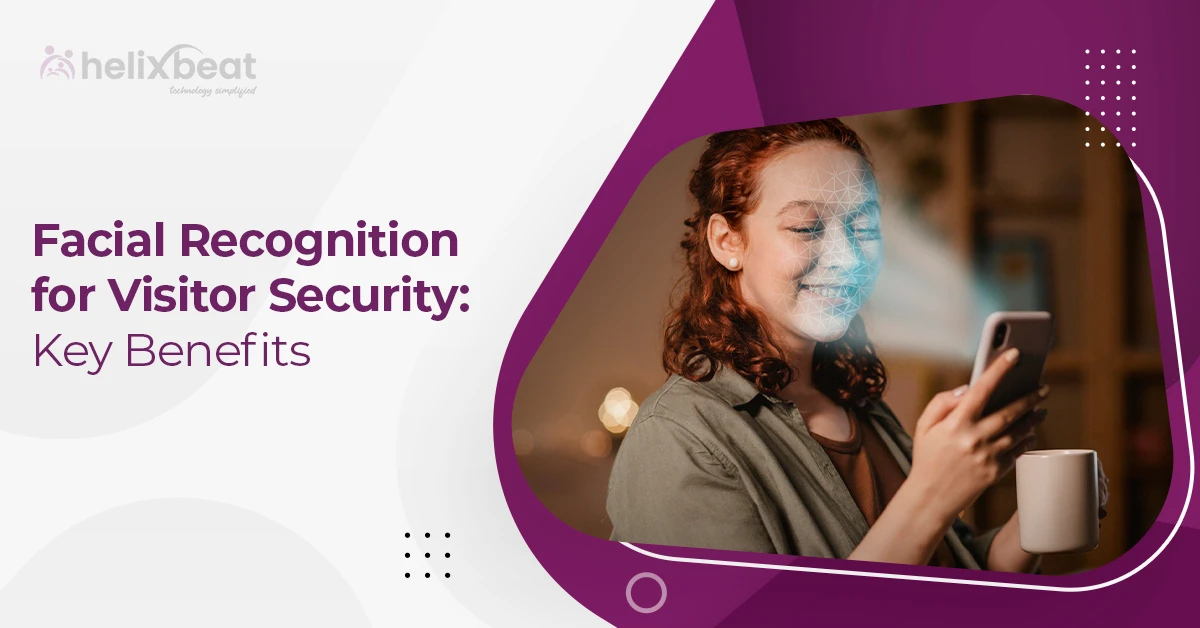Keeping visitors safe is more important than ever. Businesses, offices, and institutions need reliable ways to secure their spaces while making the check-in process smooth and hassle-free.
That’s where facial recognition steps in. It offers a perfect mix of security and convenience, replacing outdated methods like sign-in sheets and ID badges.
Think about the traditional check-in process—long lines, misplaced IDs, and the occasional fake name in a logbook. Not exactly foolproof, right? With facial recognition, your face is your key. No waiting, no paperwork, no room for errors.
It’s quick, accurate, and highly secure. Whether it’s an office, hospital, or hotel, businesses are using this technology to enhance security while ensuring a seamless visitor experience.
In this blog, we’ll explore how facial recognition improves visitor security, why it’s becoming essential, and how organizations can implement it effectively. Let’s get started!
Table of Contents
Some Amazing Statistics Highlighting How Technology is Transforming Workplaces:
- 80% of businesses using facial recognition in their visitor management systems reported improved security and faster check-ins.
- Facial recognition accuracy is reported to be 99.7%, surpassing older methods like key cards and ID checks.
- 45% faster check-ins were recorded in companies that adopted facial recognition compared to traditional methods
What is Facial Recognition Technology?
Facial recognition is a cutting-edge security tool that makes identifying people quick, easy, and highly accurate—even in crowded places. In visitor management systems, this technology takes the hassle out of check-ins, ensuring a seamless and secure experience.
Here’s how it works: When a visitor arrives, the system scans and stores their facial details in a database. The next time they visit, it compares their face to the saved data. If it’s a match, they’re granted access instantly—no need for ID cards or manual sign-ins. If not, entry is denied, keeping security tight.
Unlike fingerprint scanners, facial recognition is completely touch-free, making it a safer, more hygienic solution—especially in a post-pandemic world where reducing contact is a priority.
Why is Facial Recognition More Important Than Ever for Visitor Security?
Security threats are evolving, and traditional visitor check-in methods just don’t cut it anymore. Whether it’s an office, hospital, or school, organizations need a faster, smarter, and more secure way to manage visitors.
Facial recognition is the answer. It’s not just about convenience—it’s about security, efficiency, and reliability. Here’s why it’s a game-changer:
- No More Unauthorized Access – Fake IDs? Borrowed badges? Not anymore. Facial recognition ensures only the right people get in.
- Lightning-Fast Check-Ins – Long queues and paperwork slow things down. With facial recognition, entry happens in seconds.
- 24/7 Security Monitoring – Every check-in is logged digitally, making it easy to track and review visitor history.
- Eliminates Human Errors – AI-driven verification means no more misreading names or manual data entry mistakes.
- Completely Touchless & Hygienic – No touching, no spreading germs—just a smooth, contact-free check-in experience.
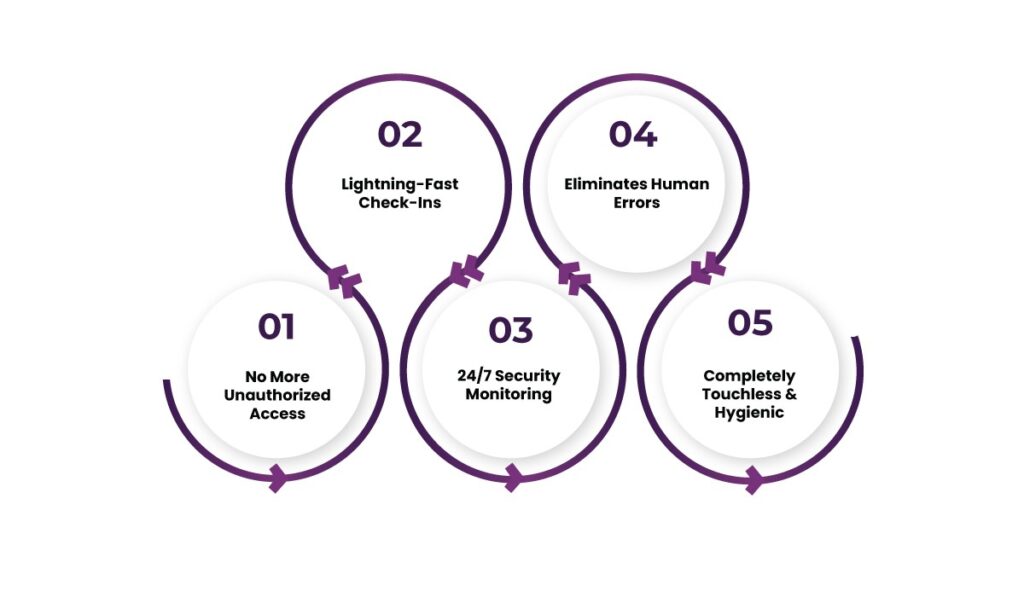
How Does Facial Recognition Work in Visitor Management?
Facial recognition takes visitor check-ins from slow and manual to fast and fully automated. Here’s how it works:
- First-Time Registration: When a new visitor arrives, the system scans their face and securely stores their unique facial features in the database—essentially creating a digital profile for future visits.
- Instant Recognition: The system instantly identifies them on their next visit by matching their live scan with the stored data. If it’s a match, access is granted within seconds—no need for ID cards, sign-in sheets, or manual verification.
- Automatic Updates for New Visitors: Didn’t pre-register? No worries! The system instantly captures their facial details and adds them to the database for smooth, hassle-free check-ins in the future.
- Multi-Tiered Access Control: Need to restrict access to specific areas? Facial recognition can assign different clearance levels based on visitor profiles, ensuring only authorized individuals can enter designated zones.
- Real-Time Alerts & Monitoring: If an unauthorized person attempts to check in, security is instantly notified. The system also maintains a real-time digital log, making it easy to track, audit, and manage visitor flow.
- Seamless Integration with Security Systems: Facial recognition can integrate with existing security solutions like CCTV, access control systems, and visitor management platforms, providing a unified security approach.
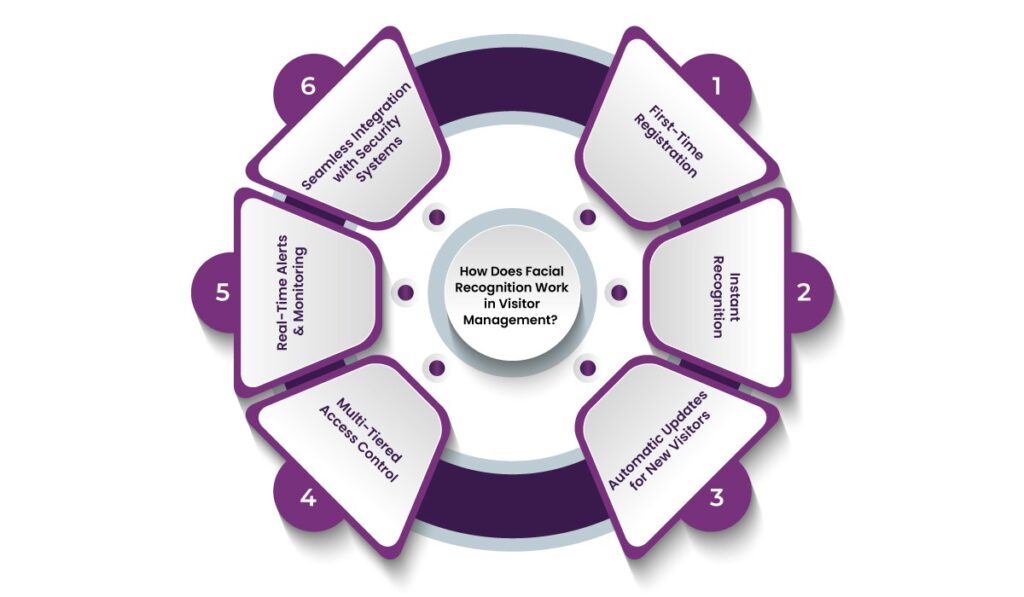
With these advanced features, facial recognition makes visitor management not just efficient but also smarter and more secure than ever before!
Key Benefits of Facial Recognition Features for Visitor Management
1. Enhanced /and Access Control
Facial recognition eliminates the risks associated with unauthorized access. Unlike key cards or passwords, a person’s face cannot be lost, stolen, or duplicated easily. The system ensures that only authorized individuals are granted access, preventing intrusions or security breaches. Moreover, it can be integrated with other security measures like alarms and monitoring systems, further enhancing the overall security of an establishment.
2. Faster Check-Ins and Reduced Wait Times
Long lines at reception areas are a thing of the past. Facial recognition speeds up check-ins, allowing visitors to gain access within seconds. The process is automated, requiring no manual ID verification, making it extremely efficient for businesses that experience a high volume of visitors. This time-saving feature not only improves operational workflow but also enhances visitor satisfaction by eliminating unnecessary delays.
3. Touchless and Hygienic
In a post-pandemic world, reducing physical contact is crucial. Unlike fingerprint scanners or ID card swipes, facial recognition is entirely contactless, ensuring a hygienic and safe check-in experience for visitors and staff alike. This touchless approach reduces the risk of spreading germs and illnesses, making it an essential feature for healthcare facilities, corporate offices, and public spaces.
4. Eliminates Fraud and Identity Theft
Traditional visitor management methods rely on ID cards, which can be faked or stolen. Facial recognition prevents identity fraud by ensuring that the person entering matches the registered data, making it impossible to impersonate someone else. This prevents unauthorized individuals from gaining access using someone else’s credentials, significantly enhancing the security of sensitive or restricted areas.
5. Seamless Integration with Existing Security Systems
Facial recognition technology can be integrated with access control systems, security cameras, and visitor management software, creating a comprehensive security ecosystem that enhances organizational safety. By syncing with these systems, businesses can streamline operations and ensure that all security measures work together cohesively to maintain high levels of protection.
6. Automated Record Keeping
With facial recognition, every visitor’s entry and exit are logged automatically. This digital record helps organizations track visitor movement, improve security audits, and comply with regulatory requirements. It eliminates manual data entry errors and ensures that there is always an accurate record of who was on the premises at any given time, aiding in investigations or compliance checks.
7. Improved Customer and Visitor Experience
A seamless and high-tech check-in experience leaves a positive impression on visitors. Whether it’s a corporate guest, hotel guest, or patient in a hospital, a smooth and efficient check-in process enhances satisfaction and convenience. Visitors no longer need to carry physical documents or wait for manual verification, making their arrival experience hassle-free and modern.
8. Scalability for Large Enterprises and Events
Facial recognition is not just for small offices—it scales effortlessly for large organizations and high-volume events. Whether managing thousands of visitors daily or securing an entire conference center, facial recognition adapts to any scale. Large businesses, stadiums, and event venues can efficiently manage visitor entry without the need for additional staff or cumbersome manual procedures.
9. Real-Time Threat Detection and Alerts
Facial recognition systems can instantly flag unauthorized individuals or persons of interest. Security teams receive real-time alerts, allowing them to take immediate action in case of potential threats. This proactive approach to security helps prevent incidents before they escalate, keeping both employees and visitors safe.
10. Cost-Effective in the Long Run
Although implementing facial recognition may require an initial investment, it reduces long-term costs associated with manual security checks, lost key cards, and administrative work. With fewer personnel required for visitor management and enhanced security, businesses can save money while improving overall efficiency.
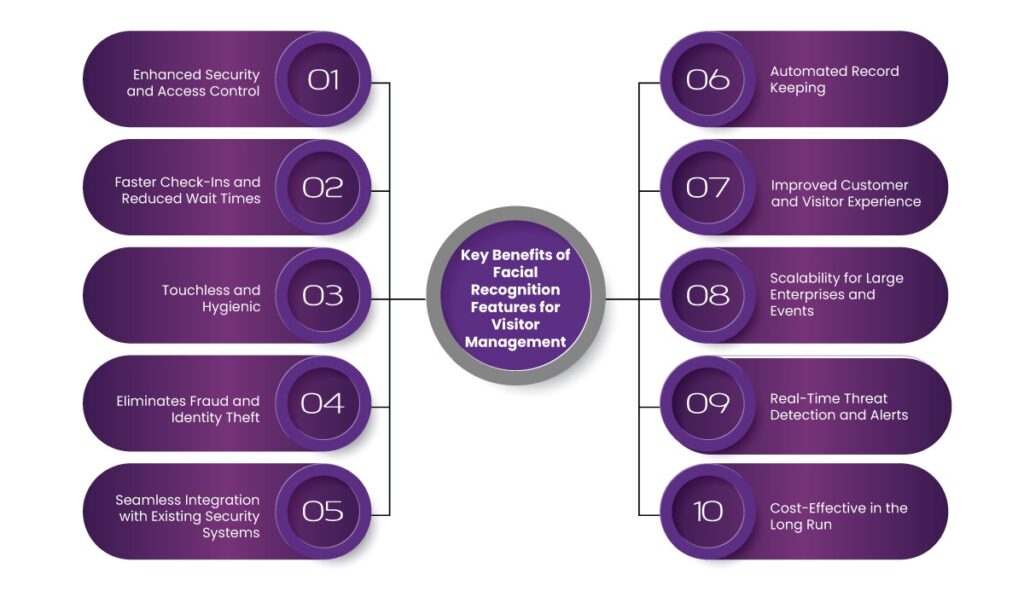
Real-world examples of facial recognition in visitor management:
- Lemon Tree Hotels: By integrating NEC’s NeoFace facial recognition technology, Lemon Tree Hotels enhanced both security and guest convenience. This system allows for effortless guest identification without any interruptions, ensuring a smooth and welcoming experience.
- Airports: Many airports, including those in the U.S., have adopted facial recognition to speed up security checks. This technology minimizes wait times while strengthening security, making the travel experience more efficient for passengers.
- Retail & Hospitality: In China, facial recognition is revolutionizing both the hotel and retail industries. Hotels leverage it for seamless check-ins, while retailers use it to deliver personalized advertisements, creating a more tailored and engaging customer experience.
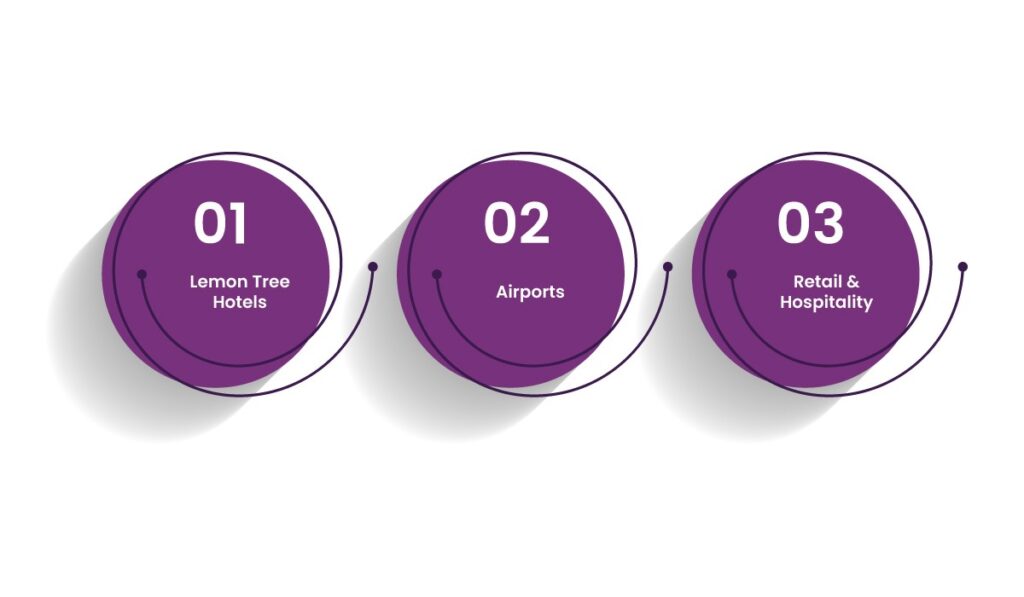
VISTA – Making Visitor Check-ins Faster, Safer, and Smarter with Facial Recognition
Managing visitors isn’t just about keeping a record of who comes in—it’s about ensuring security, efficiency, and a smooth experience. VISTA, an advanced facial recognition system, is changing the way businesses, hotels, hospitals, and offices handle visitor check-ins.
With VISTA’s AI-powered facial recognition, visitors don’t need to sign in manually or carry ID cards. The system scans their face instantly and grants access within seconds. No waiting, no paperwork—just a quick, hassle-free check-in.
Here’s what makes VISTA stand out:
- Touchless Check-ins – No need to touch surfaces or exchange ID cards, making it a hygienic and safe option.
- Instant Recognition – Returning visitors are recognized immediately, speeding up the entry process.
- Real-time Monitoring – Tracks visitor movement and logs every check-in automatically, enhancing security.
- Fraud Prevention – Ensures only authorized people enter, eliminating the risk of fake IDs or identity theft.
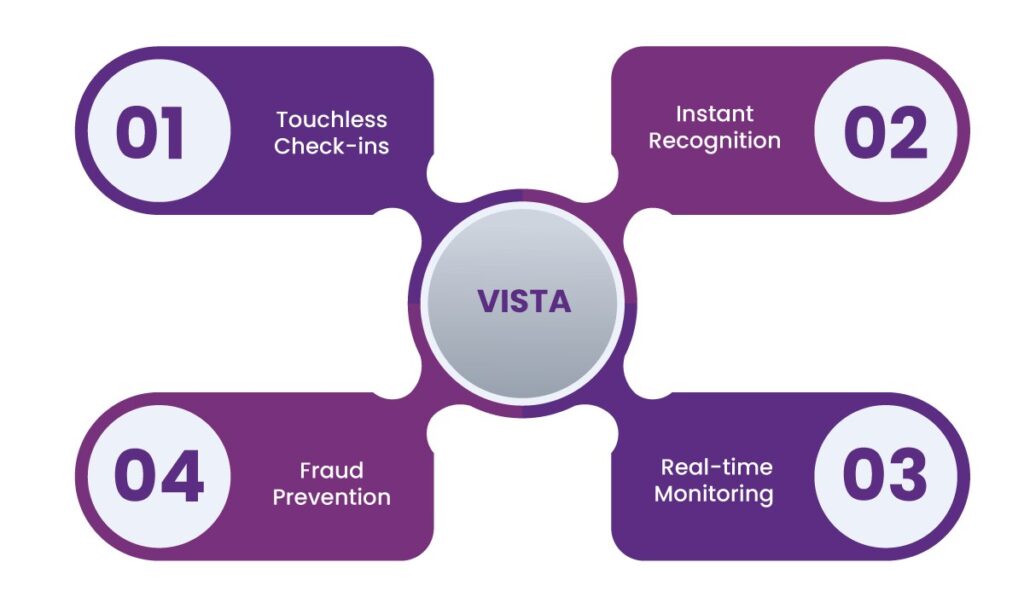
Whether it’s managing guests at a hotel, patients in a hospital, or employees in a corporate office, VISTA makes check-ins faster, safer, and smarter. Say goodbye to outdated visitor logs and hello to a seamless, AI-driven security solution!
Conclusion
At VISTA, we bring you advanced facial recognition technology to make your visitor management process smarter, faster, and more secure. With our system, visitors can check in instantly, ensuring smooth access control and improved safety for your organization.
Transform Your Visitor Experience Today!
Upgrade to VISTA’s facial recognition features to improve security, efficiency, and brand image.
Get in touch with us now to explore how our solution can enhance your visitor management process.
Frequently asked question
1. How does facial recognition improve visitor security?
Facial recognition ensures that only authorized individuals gain access, preventing unauthorized entry and identity fraud. It also provides real-time monitoring and automated visitor logs for enhanced security.
2. Is facial recognition faster than traditional check-in methods?
Yes, facial recognition enables instant check-ins, eliminating the need for ID cards or paperwork. It significantly reduces wait times, making the process faster and more efficient.
3. How accurate is facial recognition technology?
Modern facial recognition systems boast an accuracy rate of up to 99.7%, making them more reliable than traditional methods like key cards or manual ID verification.
4. Can facial recognition be integrated with existing security systems?
Absolutely! Facial recognition can be integrated with CCTV cameras, access control systems, and visitor management platforms for a comprehensive security solution.
5. Is facial recognition a touchless and hygienic solution?
Yes, facial recognition is completely touch-free, making it a safer and more hygienic alternative to fingerprint scanners or manual sign-ins—ideal for post-pandemic environments.
6. How does facial recognition prevent identity fraud?
Unlike ID cards or passwords that can be stolen or faked, facial recognition verifies a person’s unique facial features, ensuring only the right individuals gain access.
7. Can facial recognition be used in large organizations or events?
Yes, facial recognition is highly scalable and can handle high visitor volumes, making it ideal for corporate offices, hospitals, hotels, and large events.
8. Is facial recognition expensive to implement?
While there is an initial investment, facial recognition reduces costs in the long run by automating visitor management, eliminating manual errors, and enhancing security, making it a cost-effective solution. why it’s becoming essential, and how organizations can implement it effectively. Let’s get started!



